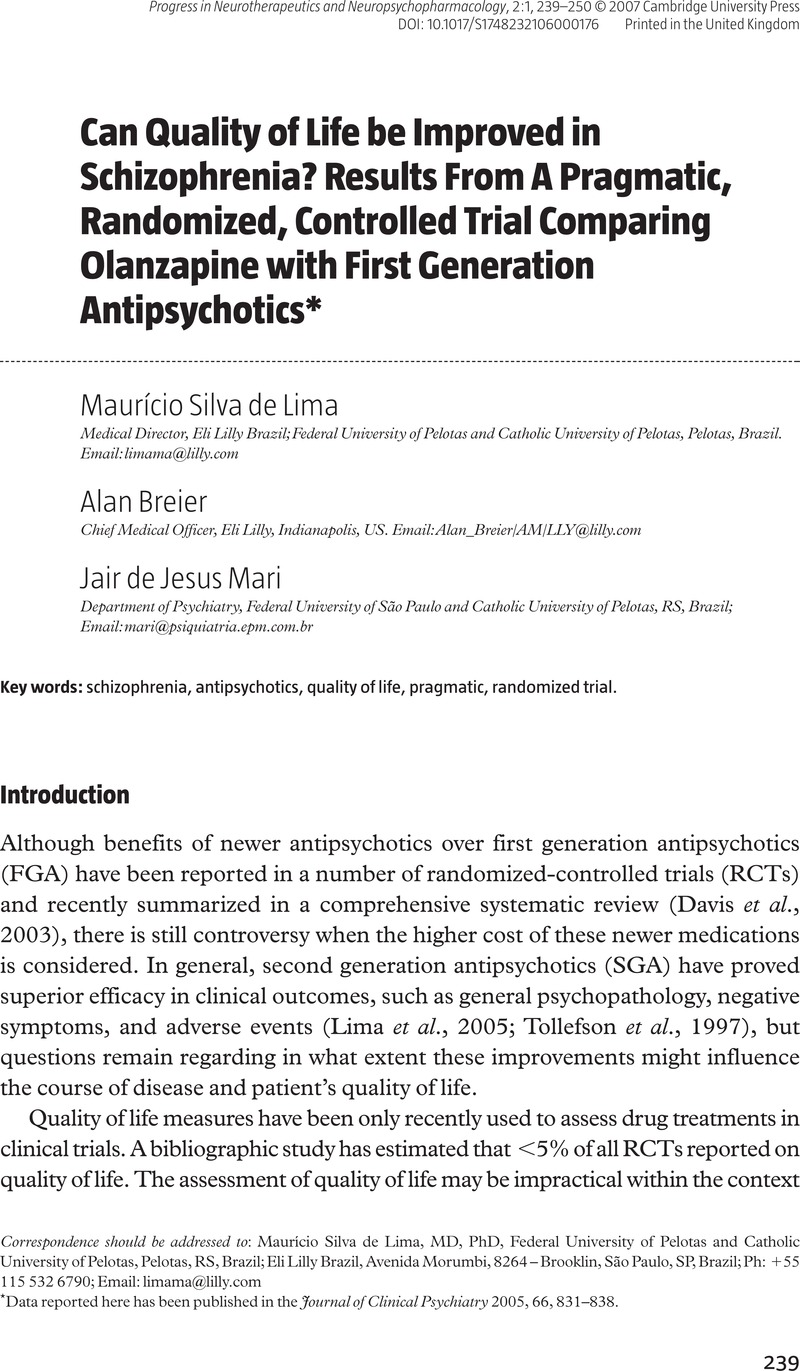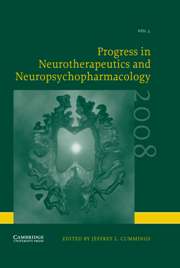No CrossRef data available.
Article contents
Can Quality of Life be Improved in Schizophrenia? Results From A Pragmatic, Randomized, Controlled Trial Comparing Olanzapine with First Generation Antipsychotics
Published online by Cambridge University Press: 12 February 2007
Abstract
An abstract is not available for this content so a preview has been provided. Please use the Get access link above for information on how to access this content.

- Type
- Review Article
- Information
- Progress in Neurotherapeutics and Neuropsychopharmacology , Volume 2 , Issue 1 , March 2007 , pp. 239 - 250
- Copyright
- © 2007 Cambridge University Press
Footnotes
Data reported here has been published in the Journal of Clinical Psychiatry 2005, 66, 831–838.
References
American Psychiatric Association (1994). Committee on nomenclature and statistics. Diagnostic and Statistics Manual of Mental Disorders – Fourth Edition. Washington, DC: American Psychiatric Association.
Beasley, Jr., C.M., Sanger, T., Satterlee, W., et al. (1996). Olanzapine versus placebo – results of a double-blind, fixed-dose olanzapine trial. Psychopharmacology, 124, 159–167.CrossRefGoogle Scholar
Beasley Jr., C.M., Dellva, M.A., Tamura, R.N., et al. (1999). A randomized, double-blind comparison of the incidence of tardive dyskinesia during long-term treatment with olanzapine or haloperidol. British Journal of Psychiatry, 174, 23–30.CrossRefGoogle Scholar
Conley, R.R., Tamminga, C.A., Bartko, J.J., et al. (1998). Olanzapine compared with chlorpromazine in treatment-resistant schizophrenia. American Journal of Psychiatry, 155, 914–920.CrossRefGoogle Scholar
Davis, J., Chen, N., & Glick, I.D. (2003). A meta-analysis of the efficacy of second-generation antipsychotics. Archives of General Psychiatry, 60, 553–564.CrossRefGoogle Scholar
Expert Group (2004). Schizophrenia and Diabetes 2003 Expert Consensus Meeting, Dublin, 3–4 October 2003: Consensus Summary. British Journal of Psychiatry, 184 (Suppl. 87), s112.
Guy, W. (1976). Psychopharmacology Research Branch, NIMH. Abnormal Involuntary Scale (AIMS). In: ECDEU Assessment Manual for Psychopharmacology, revised. DHEW Publication No. (ADM) 76-338. Rockville, MD: National Institute of Mental Health, pp. 534–537.
Hotopf, M., Churchill, R., & Lewis, G. (1999). Pragmatic randomised controlled trials in psychiatry. British Journal of Psychiatry, 175, 217–223.CrossRefGoogle Scholar
Jakovljevic, M., Dossenbach, M.R.K., et al. (1999). Olanzapine versus fluphenazine in the acute (six-week) treatment of schizophrenia. Psychiatric Danubina, 11 (1–2), 3–10.Google Scholar
Kinon, B.J., Basson, B.R., Gilmore, J.A., et al. (2001). Long-term olanzapine treatment: weight change and weight-related health factors in schizophrenia. Journal of Clinical Psychiatry, 62 (2), 92–100.CrossRefGoogle Scholar
Lieberman, J.A., Tollefson, G., Tohen, M. et al. (2003). Comparative efficacy and safety of atypical and conventional antipsychotics drugs in first-episode psychosis: a randomized, double-blind trial of olanzapine versus haloperidol. American Journal of Psychiatry, 160, 1396–1404.CrossRefGoogle Scholar
Lima, M.S., Mari, J.J., Breier, A., Costa, A.M., Sena, E.P., & Hotopf, M. (2005). Quality of life in schizophrenia: a multicenter, naturalistic, controlled trial comparing olanzapine to first-generation antipsychotics. Journal of Clinical Psychiatry 66, 831–838.CrossRefGoogle Scholar
Loza, N., El-Dosoky, A.M., Okasha, T.A., et al. (1999). Olanzapine compared to chlorpromazine in acute schizophrenia. European Neuropsychopharmacology, 9 (Suppl. 5), S291.CrossRefGoogle Scholar
Mraz, K., Gogus, A., Tunca, Z., et al. (2000). Olanzapine versus chlorpromazine in Turkey. Schizophrenia. Schizophrenia Research, 41 (1), 190.CrossRefGoogle Scholar
Revicki, D.A. (1997). Methods of pharmacoeconomic evaluation of psychopharmacologic therapies for patients with schizophrenia. Journal of Psychiatry and Neuroscience, 22 (4), 256–266.Google Scholar
Rosenheck, R., Perlick, D., Bingham, S., et al. (2003) Effectiveness and cost of olanzapine and haloperidol in the treatment of schizophrenia. A randomized controlled trial. Journal of American Medical Association, 290, 2693–2702.CrossRefGoogle Scholar
Schwartz, D., & Lellouch, J. (1967). Explanatory and pragmatic attitudes in therapeutical trials. Journal of Chronic Diseases, 20, 637–648.CrossRefGoogle Scholar
Tollefson, G.D., & Sanger, T.M. (1997). Negative symptoms: a path analytic approach to a double-blind, placebo- and haloperidol-controlled clinical trial with Olanzapine. American Journal of Psychiatry, 154 (4), 466–474.CrossRefGoogle Scholar
Tollefson, G.D., Beasley, C.M., Tran, P.V., et al. (1997). Olanzapine versus haloperidol in the treatment of schizophrenia and schizoaffective and schizophreniform disorders: results of an international collaborative trial. American Journal of Psychiatry, 154, 457–465.Google Scholar
Tunis, S.L., Croghan, T.W., Heilman, D.K., et al. (1999). Reliability, validity, and application of the medical outcomes study 36-item short-form health survey (SF-36) in schizophrenic patients treated with olanzapine versus haloperidol. Medical Care, 37 (7), 678–691.CrossRefGoogle Scholar
Zhang, P.L., Santos, J.M., Newcomer, J., Pelfrey, B.A., Johnson, M.C., & Erausquin, G.A. (2004). Impact of atypical antipsychotics on quality of life, self-report of symptom severity, and demand of services in chronically psychotic patients. Schizophrenia Research, 71, 137–144CrossRefGoogle Scholar


